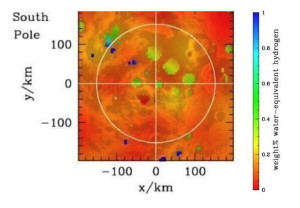Moon water – again
The question, “Is there water on the Moon?” is still with us.

The question, “Is there water on the Moon?” is still with us. Although water is not stable on the lunar surface in vacuum, the poles of the Moon contain deep craters whose floors are in permanent shadow. These dark areas are extremely cold – only about 50º above absolute zero. If a water molecule gets into one, no known physical process can remove it.
Where would such water come from? The Moon is constantly pelted by meteorites and comets, many containing water, either as ice or bound into mineral structures. This water is mostly lost to space during an impact, but some molecules may hop around on the surface for an extended time (minutes to hours). If by chance a water molecule fell into a polar dark area, it would be trapped there forever. Of course, this would be an extremely slow process, but the Moon is old (over 4,500 million years) and has plenty of time.
We will soon be obtaining new information on the poles of the Moon from the ongoing Chandrayaan-1 orbital mission. On that spacecraft, the Mini-RF SAR experiment will use radar to map the poles, including all of the dark regions. Unlike neutron spectroscopy, radar probes a couple of meters below the surface and is sensitive to the presence of ice, not hydrogen.
The first hint that there may be ice in these polar cold traps came from a radio experiment on the Clementine mission in 1994. Four years later, a small satellite called Lunar Prospector (LP) carried an instrument designed to measure the amount of neutrons given off the Moon’s surface. Hydrogen absorbs neutrons, so when the LP investigators saw a decrease in neutron flux near the lunar poles, they concluded that excess amounts of hydrogen are present there.
A problem with the Lunar Prospector data is that its maps of hydrogen concentration are low in spatial resolution; we cannot identify any structure in the data smaller than about 40 km. Thus, in the LP neutron data, we see a large, smeared out area of enhanced hydrogen. We cannot tell if this excess is confined to the dark floors of permanently shadowed craters (consistent with the presence of water ice) or just an overall enrichment of hydrogen near the poles (consistent with implanted solar wind protons.)
Last week, new models of the distribution of water ice near the lunar poles were published. These maps indicate that if the polar hydrogen is present as water ice, ice concentrations may exceed 1 weight percent in some areas. This sounds like a small amount, but when added over a large area, it could constitute hundreds of millions of tons of water ice on the Moon. Moreover, because the neutron instrument only senses the outer 30 cm of the surface, total concentrations could be up to ten times greater than these results.
Of course, a model is not new data, but merely an attempt to envision how hydrogen might be distributed over the lunar poles. In concert, both neutron and radar data sets will provide an abundance of information that may allow us to finally resolve this vexing question: Is there water on the Moon?
/https://tf-cmsv2-smithsonianmag-media.s3.amazonaws.com/accounts/headshot/blog_headshot_spudis-300x300.jpg)
/https://tf-cmsv2-smithsonianmag-media.s3.amazonaws.com/accounts/headshot/blog_headshot_spudis-300x300.jpg)